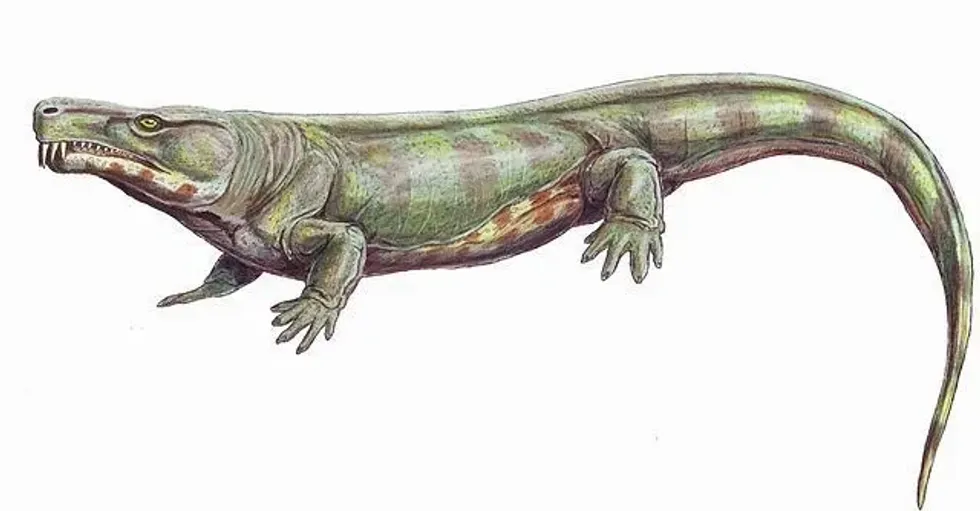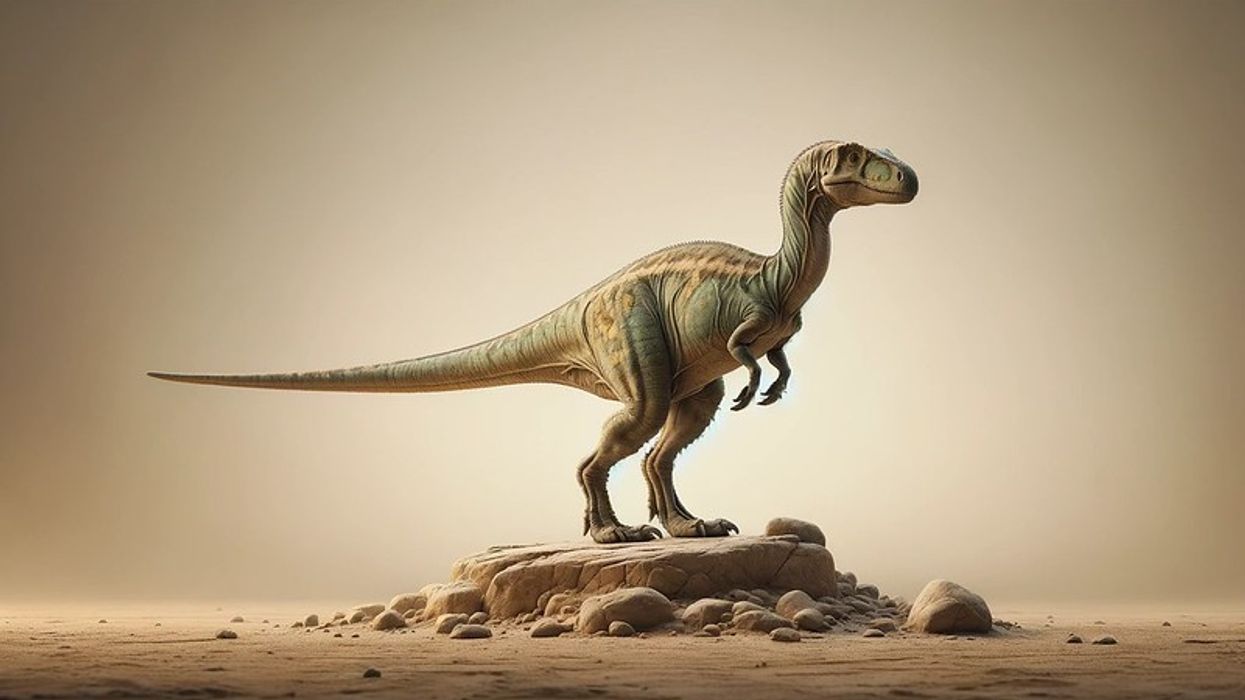Limnoscelis was a member of the clade Diadectomorpha, and the Limnoscelidae family. This animal is known to have had features that resemble a modern-day crocodile - that is, a reptile. The Limnoscelis however, was an amphibian.
There has been considerable research that shows that this animal had a bone structure and skeleton that would suggest that it was very slow-moving and led a carnivorous lifestyle!
For more relatable content, check out Palaeosaurus facts and Hungarosaurus facts.
Limnoscelis Interesting Facts
Was the Limnoscelis a dinosaur?
Limnoscelis was a genus of reptile-like amphibians that existed long before dinosaurs came into being. Hence, this genus and its two recognized species are not classified as dinosaurs.
How do you pronounce 'Limnoscelis'?
The name of this animal would be pronounced as 'lim-no-sell-is'.
What type of prehistoric reptile was a Limnoscelis?
This prehistoric reptile was a diadectomorph, which means that it belonged to the clade Diadectomorpha. The other clade that it is said to have belonged to is Seymouriamorpha. This animal was also an amphibian and had a skeleton that would very easily and readily remind us of a modern-day crocodile.
In which geological period did the Limnoscelis live?
This reptile-like amphibian is estimated to have lived on the surface of the Earth in the early Permian age. If you happen to be wondering how long ago the early Permian age was, you will be definitely taken aback by the fact that this diadectomorph genus lived no less than 251-299 million years ago!
However, it is also interesting to note that there later sprouted some speculation suggesting that these reptiles rather belonged to the late Pennsylvanian period. The climate is assumed to be warm, but colder at the end of the geological period.
When did the Limnoscelis become extinct?
The exact year during which this genus and its two species may have become extinct does not appear as a researched fact in any paper such as the American Journal of Science, which otherwise gives us a fair idea of the characteristics of the animal.
However, if we were to assume that these reptiles managed to live throughout the Permian age, they would have become extinct around 251 million years ago!
Where did a Limnoscelis live?
Since these animals were amphibians, it can be easily assumed that their habitat in North America consisted of floodplains and riverine forests. The Cutler Formation, where the fossil remains of these animals have been found in large numbers, is known to have been made of floodplains and marshes during prehistoric times.
Such a habitat would allow these reptiles to be able to feed on both large and small animals of the area.
What was a Limnoscelis's habitat?
Since the fossil remains of these animals have been found in places of North America such as New Mexico and Colorado, it may be assumed that these animals were concentrated in such areas during the early Permian period of the earth. The particular formation where fossil remains of this genus were rather concentrated in the Cutler Formation.
Who did a Limnoscelis live with?
While there are no mentions of the society that this member of the clade Diadectomorpha lived in, in any leading journals like the American Journal of Science, it may be assumed that this carnivore may not have been the most social creature.
While the Limnoscelis paludis (Williston) and Limnoscelis dynatis may have lived together, it is unlikely that an amphibian of a rather intimidating build and strength would be friendly with other animals of the area.
How long did a Limnoscelis live?
The average lifespan of a Limnoscelis is yet to be found by any paleontologist since the fossil remains of the animal are scant and hardly provide much insight when it comes to such factors.
How did they reproduce?
Since this genus is understood to be a reptile-like amphibian, it is assumed that the Limnoscelis may have been oviparous. However, there is no evidence, such as remains of eggs, that would support and validate the theory.
Limnoscelis Fun Facts
What did a Limnoscelis look like?

The most easily recognizable features of this animal include short feet and fused ankle bones. These animals also had a cranial structure and skull that would be very reminiscent of a modern-day crocodile. Research also shows that these animals may not have been the fastest, due to their short legs.
Other notable features, according to research, would include sharp teeth and a long snout.
How many bones did a Limnoscelis have?
There is not much research when it comes to the total number of bones that the Limnoscelis had. Since the entire length of the skeleton is yet to be discovered, the total number of bones in the body cannot be assumed as yet.
However, their four feet, fused ankles, and snout suggest that these animals would have had a rather complex skeleton.
How did they communicate?
While we do not know how these animals communicated, it can be assumed from the crocodile-like teeth, feet, and body that the Limnoscelis might have had a call of a similar volume and harshness.
How big was a Limnoscelis?
The average length of the Limnoscelis from the early Permian or late Pennsylvanian period of the earth is estimated to have been around 7 ft (1.5 m).
How fast could a Limnoscelis move?
It is assumed from the fact that this animal (clade Diadectomorpha, Limnoscelidae family) had short feet and fused ankles, that they were not the fastest or most agile. Paleontologists, therefore, assume that they were slow-moving and hence also fed on slow-moving prey.
How much did a Limnoscelis weigh?
The average weight of this slow reptile-like amphibian species, Limnoscelis paludis, is yet to be estimated, mainly because of the inadequate number of fossil remains that have been recovered from places such as New Mexico.
What were the male and female names of the species?
Since there are no distinct names for the two sexes of the Limnoscelis, we have decided to refer to them as male Limnoscelis and female Limnoscelis.
It is also important to understand that the American Journal of Science does not say that any morphological differences would appear between the two sexes.
What would you call a baby Limnoscelis?
Due to features that mainly include the fact that Limnoscelis was a reptile-like amphibian, we assume that this large animal would have been oviparous. Hence, the juvenile of this animal would be called a hatchling.
What did they eat?
This animal led a carnivorous lifestyle. Given the categories across which this animal is classified, it is very apparent that this large carnivore of the Late Pennsylvanian period fed on slow-moving prey. The slow-moving feature of the prey is essential since the Limnoscelis was slow as well.
How aggressive were they?
It is very unlikely that this animal would appear as a peaceful creature. Being a large carnivore that led a predatory lifestyle, it is assumed that the Limnoscelis was an aggressive creature, and fed on smaller vertebrates and other animals.
Did you know...
The fossil remains of this animal can be seen in the Museum of Natural History in New Mexico.
The categories across which this animal is classified include Diadectomorpha and Limnoscelidae.
A few almost complete post-cranial skeletons of the animal have been discovered as of yet.
What does the name 'Limnoscelis' mean?
The name Limnoscelis literally translates to 'marsh footed' and is a reference to the small feet of these animals - in comparison to other reptiles of the early Permian age.
Was Limnoscelis endemic?
The fossil remains of the Limnoscelis and similar genera have been found only in parts of North America. Since the fossil remains of this large reptile-like animal are yet to be found in other parts of the world, it is assumed that it may have been endemic.
Here at Kidadl, we have carefully created lots of interesting family-friendly prehistoric animal facts for everyone to discover! Learn more about some other creatures from our Metriorhynchus interesting facts, or Gargoyleosaurus facts for kids pages.
You can even occupy yourself at home by coloring in one of our free printable Limnoscelis coloring pages.
Main image by Dmitry Bogdanov.
Second image by Nobu Tamur.










